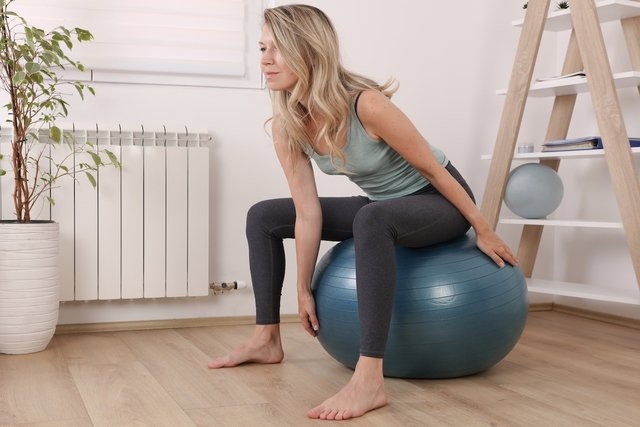In physiotherapy there are great treatment options to control urine, which are indicated before or after surgery.
Physiotherapy consists of strengthening the pelvic floor muscles to prevent the involuntary loss of urine, but for it to have the expected effect it must be performed daily at home, in addition to going to the clinic at least once a week.
In physiotherapy for urinary incontinence, Kegel exercises, electrical stimulation, biofeedback and vaginal cones can be used. This type of treatment can be indicated for all cases of incontinence, whether urgent or stressful, in men, women, children, and even after removal of the prostate.

How physiotherapy is done
Some techniques that can be performed in physiotherapy for urinary incontinence are:
1. Kegel Exercises
To perform Kegel exercises, you must first identify which are the pelvic floor muscles: just try to hold your pee while urinating. If you can at least reduce your urine stream a little, it means you are contracting the right muscles.
To perform these exercises you must empty your bladder by peeing, and then you must lie on your back and do this contraction 10 times in a row, and then you must rest for 5 seconds. Then you must do 9 more repetitions of this series, totaling 100 contractions.
After a few days, you can add a ball between your legs or elastic bands to help maintain concentration and make it easier to perform the full series correctly.
2. Hypopressive exercises
To perform these exercises, you must sit or stand, and pull in your belly as much as possible, while also sucking in your pelvic floor muscles.
While performing this exercise you should breathe normally, but to ensure that the muscles inside the vagina are being contracted correctly, you can combine it with the use of electrical stimulation.
3. Vaginal cones
A few weeks after being able to perform Kegel exercises correctly, the physiotherapist may recommend the introduction of small cones inside the vagina, to further strengthen the pelvic floor muscles.
The cones have different weights, and you should start with the lightest one first. For best results, the physiotherapist may recommend that the exercise be performed in different positions, sitting, lying down or standing, with the aim of not letting the cone fall out of the vagina.
The first exercises should be performed with the woman lying down and then the intensity of the exercises should increase until the woman is able to keep the cone inside the vagina for at least 5 seconds in a standing position, and then when performing a squat, for example.
Another exercise is to insert the cone into the vagina and not let it fall while walking for 15 to 20 minutes.
Read too: Female urinary incontinence: what it is, symptoms, causes and treatment
5. Electrostimulation
Electrostimulation is another resource in which the device is placed inside the vagina or around the penis and it emits a light electrical current, completely bearable, which causes the perineum to contract involuntarily.
Studies have proven that this does not bring a great benefit in the treatment, but it can be of great help for women who do not know exactly which muscle they should contract, making it a good option for the first sessions.
5. Biofeedback
Thus, as in electrical stimulation, a small device must be inserted inside the vagina, connected to a computer, which will generate images and sounds during the contraction of the perineum.
This device can be useful for women to be able to identify the muscles they need to contract, making them more aware of the force they need to exert during each movement.
6. Good sitting posture
It is also part of the treatment to always maintain a good sitting posture, because this way there is less pressure on the pelvic floor, which helps to cure incontinence faster.
To sit in the correct posture, you must always sit on top of your butt bones, without crossing your legs, and maintain a small contraction of your abdominals.
In this position, the pelvic floor muscles are naturally strengthened.
Urinary incontinence treatment time
The treatment time for urinary incontinence depends on the degree of involvement of the perineum and the person’s commitment to performing the exercises.
The average duration of treatment varies from 6 months to 1 year, and in approximately 6 to 8 weeks it is possible to notice the first results.
But after this period, it is recommended to continue performing the exercises weekly, to guarantee results for long periods.
In some cases, the doctor may recommend surgery to cure incontinence, but within approximately 5 years, it is common for the same symptoms to reappear, making it necessary to resort to physiotherapy again.
How to know if the treatment is having an effect
To confirm that the treatment carried out is having the expected effect, the physiotherapist can use the perineometer (Wilcoxon test) and the test where 2 fingers are inserted into the vagina, asking for contraction of the perineum (Wilcoxon test).
This way it is possible to assess the contraction capacity of these muscles from the first session.

Sign up for our newsletter and stay up to date with exclusive news
that can transform your routine!
Warning: Undefined array key "title" in /home/storelat/public_html/wp-content/plugins/link-whisper-premium/templates/frontend/related-posts.php on line 12
Warning: Undefined array key "title_tag" in /home/storelat/public_html/wp-content/plugins/link-whisper-premium/templates/frontend/related-posts.php on line 13



